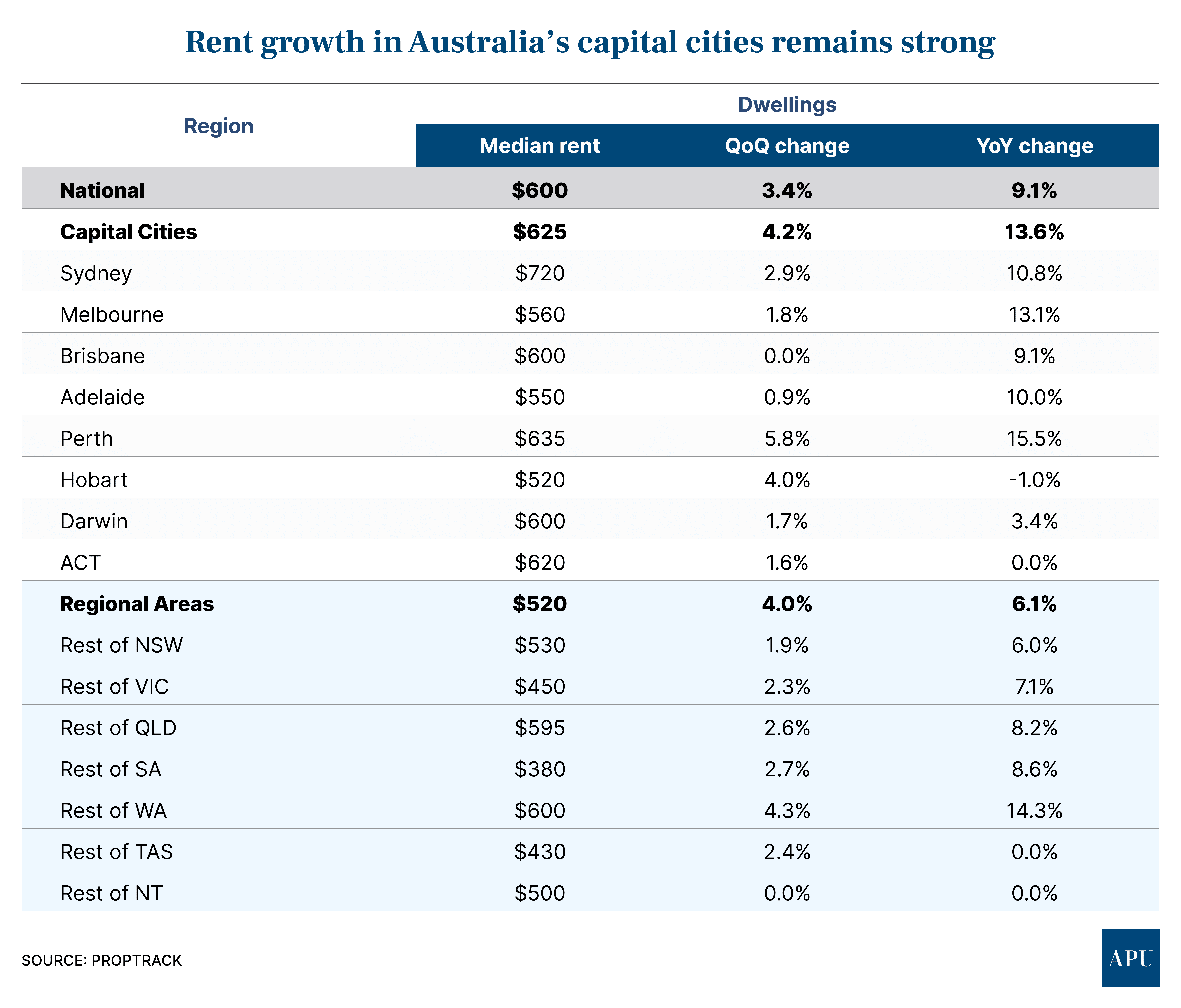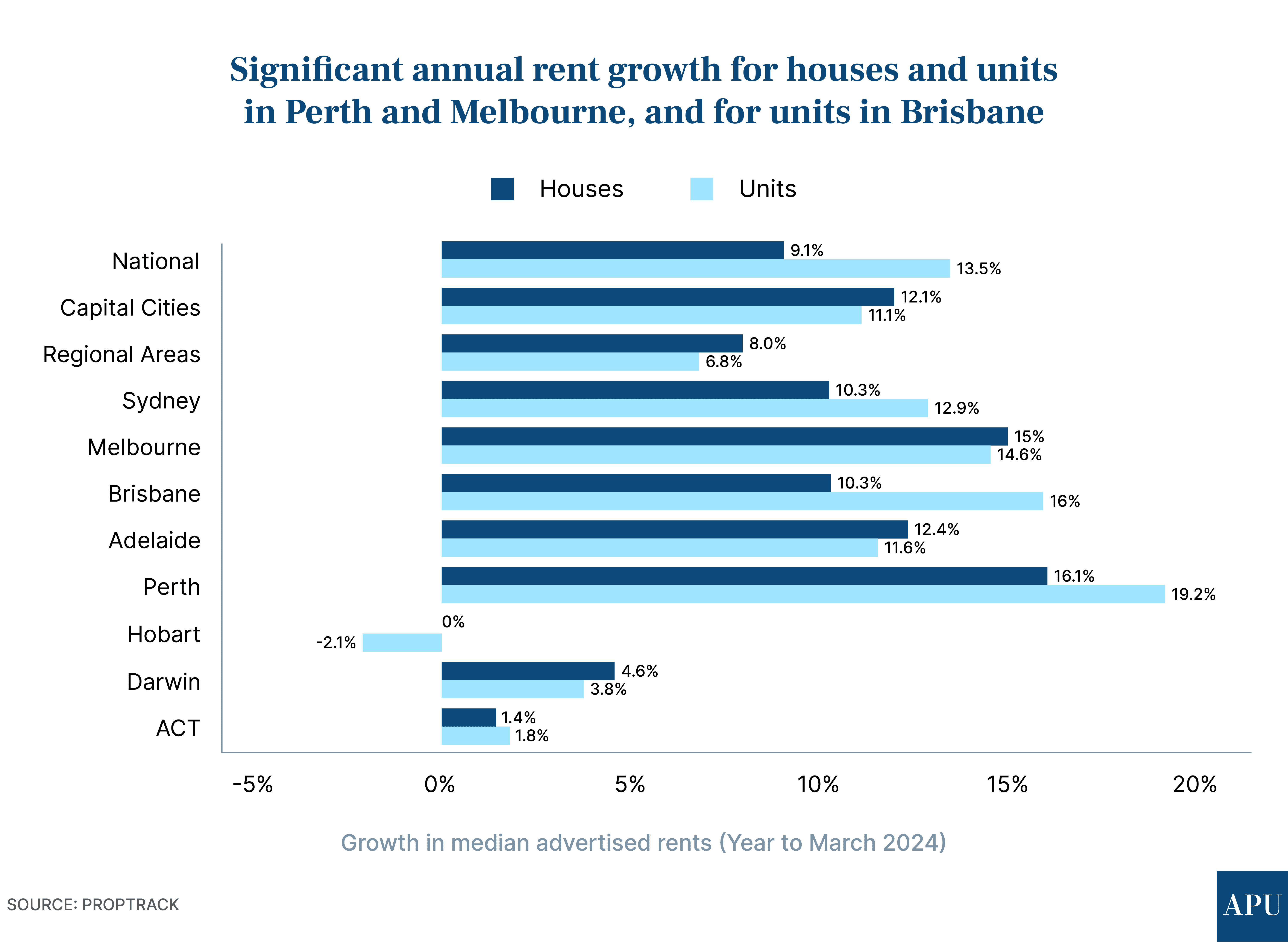Features > Property News & Insights > Housing Trends
Rents at record levels in most Australian cities

KEY POINTS
- Domain and PropTrack have released price data which shows rents are at record levels in all capital cities, except when it comes to units in Hobart and houses in Canberra
- Rents in the capital cities have continued to grow strongly since the start of the year, with the median capital city weekly rent now around $625 a week
- However, both property analytics firms have questioned how long the current sustained period of high rental growth will continue
Two property analytics firms have both recorded new median rental price records in the majority of Australia’s capital cities.
However, in some hope for tenants battered by higher and higher asking prices, both Domain and REA Group’s PropTrack say they believe that while the rental market will remain tight for the foreseeable future, the current rate of rental price growth cannot continue.
Domain

Domain’s latest rent report for the March quarter of 2024 says Australia actually experienced a reacceleration of rental growth over the first quarter of 2024.
It says at the end of March, rents for houses had reached a record high across its combined capitals measure at $630 weekly, up 5% or $30, marking the steepest quarterly gain in 17 years and the second-highest on record.
It says house rents were at record highs in all cities apart from Canberra, and every capital except Darwin and Hobart (unchanged) witnessed a quarterly rise.
Rents for units across the combined capitals were also at a record high, coming in only slightly lower at $620 weekly, up at 3.3% or $20, and continuing a record-breaking streak of 11 successive quarters of growth.
Only unit rentals in Hobart weren’t at a record price high.
Again Perth was the standout city for growth, with house rents up 18.2% in the year to the end of March, with units up an eye-watering 22.2%.
Units in Brisbane also saw spectacular growth (18%), while both houses and units saw annual rent growth of more than 14% in Melbourne.
Domain says that while rental conditions displayed “the seasonal strength” usually found in the first quarter of the year, a continuing imbalance between the demand for rental properties and actual supply is “still clearly placing (upward) pressure on rents.”
However, the property analytics firm also says it can’t be sure the reacceleration of house-rental growth in the capital cities is just down to the time of year, “as annual gains have momentum and quarterly growth is about a third higher than the March quarter of 2023.”
PropTrack

The findings in PropTrack’s latest Market Insight Report are not wildly different from Domain’s numbers, although sometimes harder to segment because of their tendency to often bundle dwelling types (houses and units) together.
Nevertheless, the data points to new record rental prices at the end of March 2024 in all capitals except Hobart.
The firm says advertised rental prices continue to increase at “a fast pace”, with median prices up 3.4% nationally since the start of 2024 to $600 per week, while capital city growth was stronger at 4.2% to hit a median rent of $625 per week.
Like rivals Domain, PropTrack economist Paul Ryan notes that “the first quarter, when many are searching for new rentals, is traditionally strong.”
But he notes, “When looking at the longer-term we continue to see rent growth moderate, with a 9.1% increase over the past year, the slowest result since December 2021.”
Paul Ryan points to rent pressure remaining “firm in most capitals, with weekly rents jumping $75 (or 13.6%) over the past year.”
“There has been some noticeable slowing in Brisbane and Adelaide,” he says, “which saw little growth over the past three months – providing welcome respite from the rapid rent increases since the pandemic.”

Like Domain, PropTrack’s annual numbers show Perth has been the standout city for advertised rental price growth, with houses up 16.1% in the year to the end of March and units up 19.2%.
Brisbane unit rents have also performed strongly (up 16% in a year), while both houses and units in Melbourne have seen advertised rents grow more than 14.5%.
The outlook
One thing both property analytics firms agree on is that the pace of rental price growth that we’ve seen over the last couple of years can’t continue.
“Rent growth is slowing, but rental market conditions remain very tight, with vacancy rates at record lows,” PropTrack economist Paul Ryan says.
He points to what he calls “strained affordability” for tenants, “as weekly rents have increased $180 nationally since the pandemic,” suggesting the price renters will pay for a property may begin “topping out”.
Domain’s Chief of Research and Economics, Dr Nicola Powell, predicts what she calls “a tipping point” later this year when rental price growth will slow.
“Currently, we are seeing the number of prospective tenants per rental listing ease, suggesting some pressure has been lifted.”
“This could be an early indicator of an increase in vacancy rates sometime this year,” she says.
“Also, international student visa applications have turned a corner and started to fall for the first time in more than two years, population growth is likely to have peaked, and the federal government has introduced a migration strategy that will slow population growth.”
Dr. Powell also points to the potential impact of new government schemes, which may enable some renters to make the transition to becoming owners.
“Homeownership is also at the forefront with incentives in place (such as Queensland doubling the first-home buyer grant and the federal government's “Help to Buy” shared equity scheme), which will help transition some to being owners or fast-track others to a more affordable purchase,” she says.
Stay Up to Date
with the Latest Australian Property News, Insights & Education.




.png?width=292&height=292&name=Copy%20Link%20(1).png)
 SIGN UP FOR FREE NEWSLETTER
SIGN UP FOR FREE NEWSLETTER








.jpg?width=1920&height=1080&name=Warning%2c%20You%20Might%20Be%20Facing%20Higher%20Taxes%20Soon%20(1).jpg)





.png?width=1920&height=1080&name=Rate%20Drops%20Signal%20BIGGEST%20Property%20Boom%20in%20DECADES%20(1).png)

.jpg?width=1920&height=1080&name=Labor%20vs%20Liberal%20These%20Housing%20Policies%20Could%20Change%20the%20Property%20Market%20Forever%20(1).jpg)
.jpg?width=1920&height=1080&name=QLD%20Slashes%20Stamp%20Duty%20Big%20News%20for%20Investors%20%26%20Home%20Buyers%20(1).jpg)
.jpg?width=1920&height=1080&name=Trump%20Just%20Slapped%20Tariffs%20%E2%80%93%20Here%E2%80%99s%20What%20It%20Means%20for%20Australia%20(1).jpg)
.jpg?width=1920&height=1080&name=Federal%20Budget%202025%20More%20Debt%2c%20No%20Housing%20%E2%80%93%20Here%E2%80%99s%20What%20You%20Need%20to%20Know%20(1).jpg)
.jpg?width=1920&height=1080&name=Australias%20Housing%20Crisis%20is%20about%20to%20get%20MUCH%20Worse%20(New%20Data%20Warns).jpg)
%20(1).jpg?width=1920&height=1080&name=Australias%20RENTAL%20CRISIS%20Hits%20ROCK%20BOTTOM!%20(2025%20Update)%20(1).jpg)
%20(1).png?width=1920&height=1080&name=Is%20Adelaide%20Still%20a%20Good%20Property%20Investment%20(2025%20UPDATE)%20(1).png)
.jpg?width=1920&height=1080&name=RBA%20Shocks%20with%20Rate%20Cuts!%20What%E2%80%99s%20Next%20for%20Property%20Investors%20(1).jpg)
%20(1).jpg?width=1920&height=1080&name=I%20Predict%20The%20Feb%20Rate%20Cut%20(My%20Price%20Growth%20Prediction)%20(1).jpg)
.png?width=1920&height=1080&name=Why%20Property%20Prices%20Will%20Rise%20in%202025%20Market%20Predictions%20(1).png)
.jpg?width=1920&height=1080&name=Why%20Investors%20Are%20Choosing%20Apartments%20Over%20Houses%202%20(1).jpg)
.jpg?width=1920&height=1080&name=Why%20Rate%20Cuts%20Will%20Trigger%20A%20Property%20Boom%20(1).jpg)
.jpg?width=1920&height=1080&name=Retire%20On%202Million%20With%20One%20Property%20(Using%20SMSF).jpg)
.jpg?width=1920&height=1080&name=4%20Reasons%20Why%20You%20Should%20Invest%20in%20Melbourne%20Now%20(1).jpg)
%20(1).jpg?width=1920&height=1080&name=Old%20Property%20vs%20New%20Property%20(Facts%20and%20Figures%20Revealed)%20(1).jpg)
%20(1).jpg?width=1920&height=1080&name=Will%20The%20New%20QLD%20Govt%20Create%20a%20Property%20Boom%20or%20Bust%20(My%20Prediction)%20(1).jpg)
%20Scott%20Kuru%20(1).jpg?width=1920&height=1080&name=Inflation%20Hits%20Three-Year%20Low%20(Will%20RBA%20Cut%20Rates%20Soon)%20Scott%20Kuru%20(1).jpg)
.jpg?width=1920&height=1080&name=How%20to%20Buy%20Investment%20Property%20Through%20SMSF_%20The%20Ultimate%20Guide%20(1).jpg)
.jpg?width=1920&height=1080&name=Victoria%20Slashes%20Stamp%20Duty%20Melbourne%20Set%20to%20Boom%20Scott%20Kuru%20(1).jpg)
.png?width=1571&height=861&name=Are%20Foreign%20Buyers%20Really%20Driving%20Up%20Australian%20Property%20Prices%20(1).png)
.jpg?width=1920&height=1080&name=The%20Single%20Factor%20That%20Predicts%20Property%20Growth%20Regions%20(1).jpg)
%20Scott%20Kuru%20(1).jpg?width=1920&height=1080&name=My%20Prediction%20On%20Rates%20%26%20Negative%20Gearing%20(Market%20Crash)%20Scott%20Kuru%20(1).jpg)

-1.png?width=1920&height=1080&name=Major%20Banks%20Cut%20Rates%20Will%20RBA%20Follow%20Suit%20(Sept%20Rate%20Update)-1.png)
%20Scott%20Kuru-1.png?width=1920&height=1080&name=Rate%20Cut%20Coming%20What%20New%20Zealands%20Move%20Means%20for%20Australia%20(Sept%20Prediction)%20Scott%20Kuru-1.png)
%20(1).jpg?width=1920&height=1080&name=Buy%20when%20the%20interest%20rates%20are%20high!%20(Why%20you%20must%20buy%20now!)%20(1).jpg)
.jpg?width=1920&height=1080&name=Carms_Revised%20Taxes%20Due%20Aug%209%20YT%20Thumbnail02%20(1).jpg)
.jpg?width=1920&height=1080&name=Carms_Too%20Little%20Too%20Late%20Aug%207%20YT%20Thumbnail01%20(1).jpg)









.jpg?width=1920&height=1080&name=Carms_Rate%20Drop%20In%20July%20Jun%2010%20YT%20Thumbnail02%20(1).jpg)
.jpg?width=1920&height=1080&name=Carms_Own%20a%20Property%20V6%20Jun%205_YT%20Thumbnail%20(1).jpg)









.png?width=1920&height=1080&name=Artboard%201%20(3).png)






.jpg?width=1920&height=1080&name=YT%20thumbnail%20%20(1).jpg)

